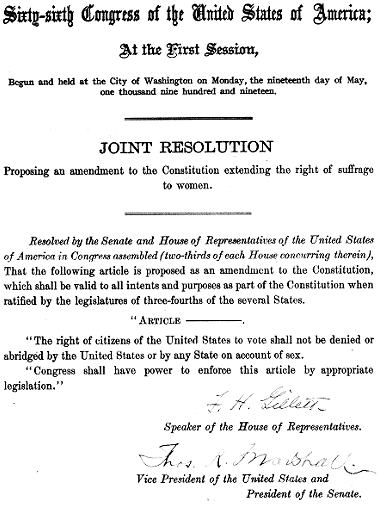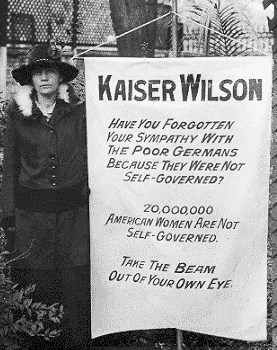
House Joint Resolution 1 proposing the 19th amendment to the states
August 1995 marked the 75th anniversary of the ratification of the 19th amendment to the Constitution. The amendment guarantees all American women the right to vote. Achieving this milestone required a lengthy and difficult struggle; victory took decades of agitation and protest. Beginning in the mid-19th century, several generations of woman suffrage supporters lectured, wrote, marched, lobbied, and practiced civil disobedience to achieve what many Americans considered a radical change of the Constitution. Few early supporters lived to see final victory in 1920.

House Joint Resolution 1 proposing the 19th amendment to the states
Note: The borders of the above document have been reduced to permit legibility. You can display a high-resolution version of the entire 19th amendment to the Constitution (87K JPEG file).

Suffrage Parade, New York City, ca. 1912
(208-PR-14M-1)
Between 1878, when the amendment was first introduced in Congress, and August 18, 1920, when it was ratified, champions of voting rights for women worked tirelessly, but strategies for achieving their goal varied. Some pursued a strategy of passing suffrage acts in each state--nine western states adopted woman suffrage legislation by 1912. Others challenged male-only voting laws in the courts. Militant suffragists used tactics such as parades, silent vigils, and hunger strikes. Often supporters met fierce resistance. Opponents heckled, jailed, and sometimes physically abused them.
By 1916, however, almost all of the major suffrage organizations were united behind the goal of a constitutional amendment. When New York adopted woman suffrage in 1917 and when President Woodrow Wilson changed his position to support an amendment in 1918, the political balance began to shift in favor of the vote for women. On May 21, 1919, the House of Representatives passed the amendment, and 2 weeks later, the Senate followed. When Tennessee became the 36th state to ratify the amendment on August 18, 1920, the amendment passed its final hurdle of obtaining the agreement of three-fourths of the states. Secretary of State Bainbridge Colby certified the ratification on August 26, 1920, and the face of the American electorate changed forever.
 During World War I, militant suffragists, demanding that President Wilson
reverse his opposition to a federal amendment, stood vigil at the White
House and carried banners such as this one comparing the President to
Kaiser Wilhelm II of Germany. In the heated patriotic climate of wartime,
such tactics met with hostility and sometimes violence and arrest.
During World War I, militant suffragists, demanding that President Wilson
reverse his opposition to a federal amendment, stood vigil at the White
House and carried banners such as this one comparing the President to
Kaiser Wilhelm II of Germany. In the heated patriotic climate of wartime,
such tactics met with hostility and sometimes violence and arrest.
(165-WW-600A-5)
Return to the Online Exhibit Hall page
Back to the Constitution
webmaster@nara.gov